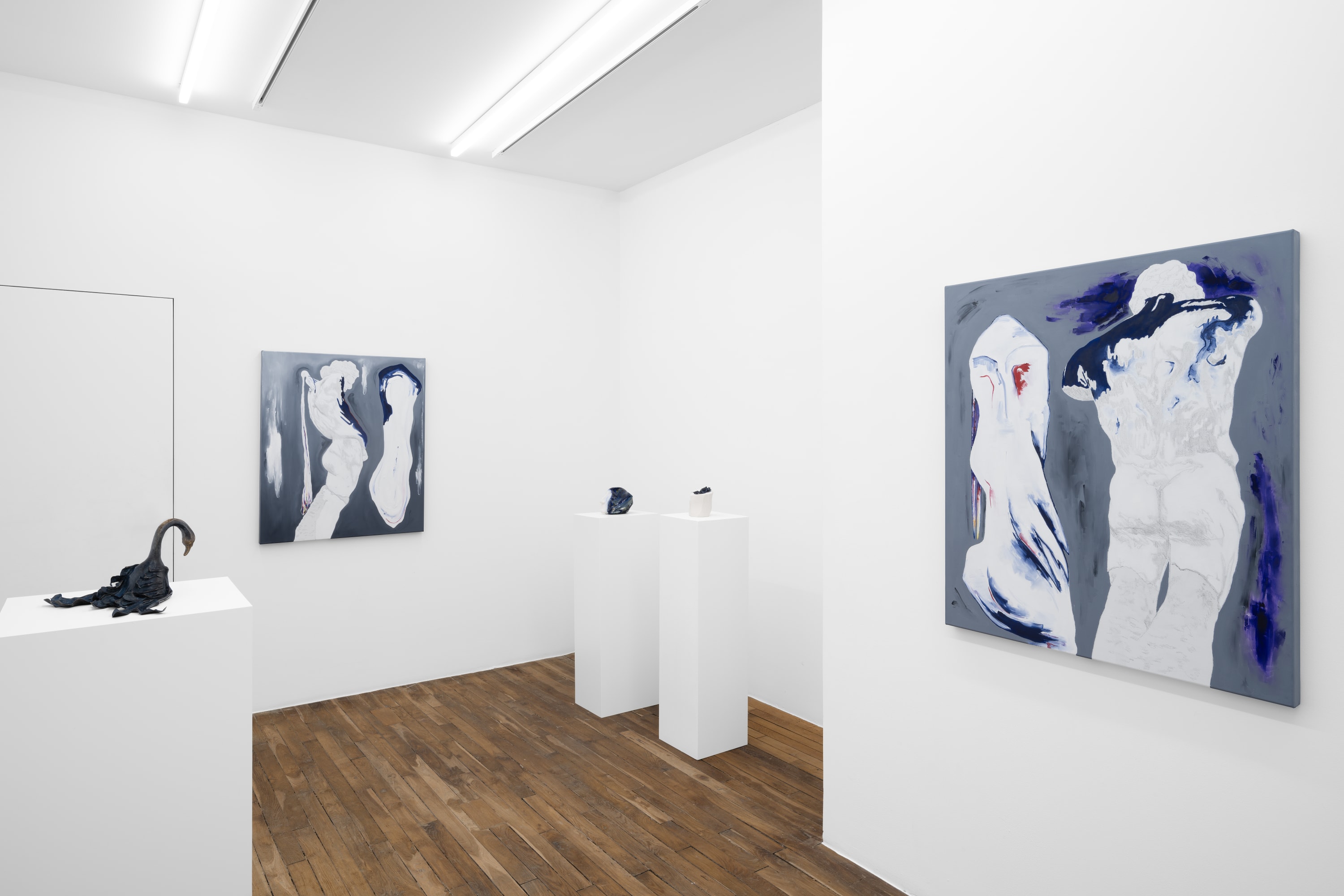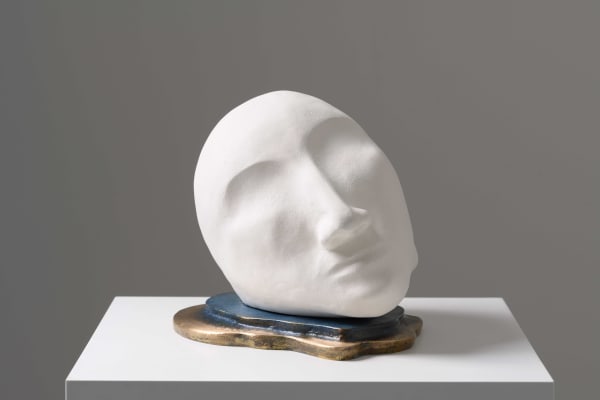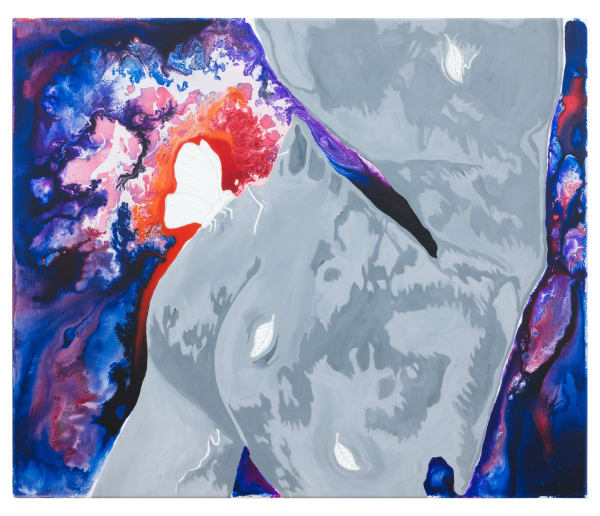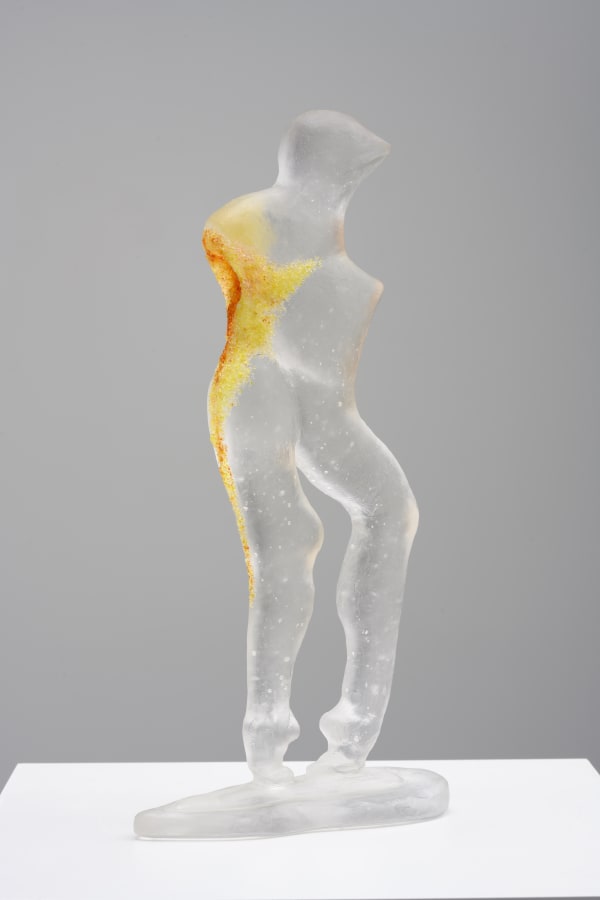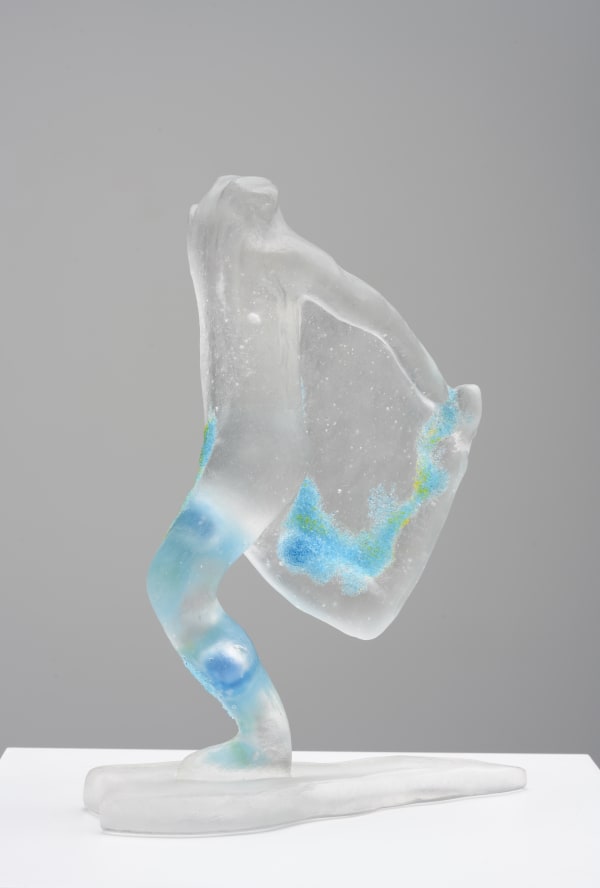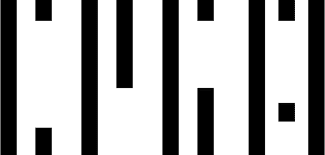-
Galerie Peter Kilchmann is pleased to present the very first solo exhibition in France of the German artist Grace Schwindt (b. 1979, lives and works in London and Sicily) in our gallery in Paris. The exhibition features a dynamic interaction of newly conceived paintings and earlier sculptures in glass, ceramics, and bronze.
-
-
Following the great success of Schwindt’s premiere in Zurich, the exhibition in Paris represents a continuation and new perspectives on Schwindt’s engagement with trauma, injury, and the acceptance of these through strategies of tenderness and touch. Inspired by literary critic Edward W. Said, Schwindt advocates for direct human encounters rather than intellectual understanding of cultures from a distance. She seeks to disrupt narratives on humans and bodies based on concepts of separation, instead promoting a history shaped by immediate touch. In doing so, she describes how, beyond our cultural influences, we are inextricably connected to nature, and this primal imprint is fragile and in need of protection. Even though the rational penetration of the mysterious and unstoppable metamorphoses of all life remains hidden from us, this very circumstance opens infinite possibilities for coexistence. “We need to concentrate on the slow working together of cultures that overlap, borrow from each other, and live together in far more interesting ways than any abridged or inauthentic mode of understanding can allow. (...) Most important, humanism is the only, and I would go so far as to say, the final resistance we have against the inhuman practices and injustices that disfigure human history. (...) Can one divide human reality, as indeed human reality seems to be genuinely divided, into clearly different cultures, histories, traditions, societies, even races, and survive the consequences humanly?” (Edward W. Said).
-
At the heart of Schwindt’s practice is the injured human body, inspired by ancient sculptures that she has researched for many years in various museums, in the context of conservation history, and through discussions with archaeologists. The Museum M in Leuven (Belgium) will dedicate a solo exhibition to this topic next year. In her research on Hellenistic bronze figures found on the seabed off Sicily, the very location of the discovery already provides an enormous amount of information, such as climatic conditions, trade relations, cultural exchange, or migration movements.
-

-
Schwindt is fascinated by these sculptures as carriers of a history of gaze on the body that has significantly shaped beauty ideals for centuries, extending beyond classicism to the present day. Schwindt is interested in the cultural heritage that has influenced how we view and encounter bodies, and she detects in these damaged and broken bodies an opportunity to, at best, reorient our gaze. She portrays the ancient bodies in their state as matter exposed to time and tides, with their flaws and changes, but not as isolated objects of study, rather as creatures intertwined with and embedded in nature, whose surfaces have been inhabited over centuries by creatures and marine plants, touched by the elements like a landscape. Inspired by these fragments of the past, which were either submerged under water on the seabed or buried in the earth for centuries, Grace emphasizes the depths of nature as a protective space, where the figures are not isolated or forgotten, but connected, and their resonance with everything around them is evident.
-
Schwindt is fascinated by the web of unevenness, traces, and patina that spread over the bodies like a blanket, planted on these bodies over centuries, ultimately protecting them from our denatured gaze. In paintings such as Memory of a Dance, various elements of these fragmented bodies float almost dancing and timelessly in a predominantly blue-grey organic mass of freely moving glazes. The variety in the treatment of the painting surfaces, from delicate transparency to dense intensity, reads like cartographic descriptions on the bodies and echoes the surrounding space. In When a Body Becomes a Landscape, lines seem to spontaneously wander across the body, as do the oil and ink, developing a certain autonomy. Both the figure and the line and color fields are in motion and transformation, extending expansively beyond the edges of the image. The reason for these metamorphoses remains enigmatic and can only be understood as the primal force of life: the indeterminable as a fundamental principle of nature in flux.
-
Aiding in this mysterious process are representatives of the animal world, especially birds, who act as guardians, messengers, or mediators supporting the transformations, however never appear fixed in a specific role but instead at times, become active protagonists and appear in different stages of transformation themselves. Schwindt is interested in how birds have been used to represent specific symbolism in art and film histories and intends to interrupt them. The expansive and shielding spread of the wings of butterflies and birds before the bodies, as seen in Touching Figure or Butterflies and Falling Leaves, and their “docking” at the edges, as well as their appearance in groups, as in Encounter, highlight nature's role as gatekeeper and shield from our intrusive and categorizing gaze. Like in Encounter, they are positioned at the joints between body and environment, initiating the fusion of all image elements. The prominent position of the bird with human features, centrally above in When a Body Becomes a Landscape, spreading its wings welcomingly and exchanging an intense, loving gaze with the figure, emphasizes the importance of tenderness and touch as drivers of transformation and healing. It is about honoring wounds and injuries, showing them as part of the natural balance, and allowing them to exert their strength. Especially the butterflies, as in Resting Butterfly or Butterflies and Falling Leaves, speak of transformation in various stages and the simultaneous beauty in the face of decay, as the emergence of the delicate butterfly heralds its death just a few weeks later.
-
-
 Grace Schwindt, Encounter with a Butterfly at Night, 2024
Grace Schwindt, Encounter with a Butterfly at Night, 2024 -
 Grace Schwindt, Resting Butterfly, 2024
Grace Schwindt, Resting Butterfly, 2024 -
 Grace Schwindt, Butterflies and Falling Leaves, 2024
Grace Schwindt, Butterflies and Falling Leaves, 2024 -
 Grace Schwindt, Encounter, 2024
Grace Schwindt, Encounter, 2024 -
 Grace Schwindt, Touching Figures, 2024
Grace Schwindt, Touching Figures, 2024 -
 Grace Schwindt, Dancing with a Shadow, 2024
Grace Schwindt, Dancing with a Shadow, 2024 -
 Grace Schwindt, Perfect Fragments, 2024
Grace Schwindt, Perfect Fragments, 2024
-
-
Dance and performance are closely related forms of expression for Schwindt, and the moving moment, the flow, the transition, and the transformative are felt in all her media. Schwindt also opposes linear definitions of media and space with alternative concepts. The glass sculptures in particular mark the transition of the painted figures into three-dimensionality. The grey-white of the paintings is reflected in the transparent body formations of glass, and the freely flowing color gradients in blue, black, or yellow on the canvases seem to move autonomously through the space, playfully populating the glass objects like in Steel Blue Dance, Orange Dance, or Pink Dance from 2019. The dancing body fragments, also inspired by ancient artifacts, are accompanied in their rhythm by streaks of color, almost giving the impression they will release themselves into the surrounding space at any moment, leaping from figure to figure. The incomplete seems to be in a state of growth and transformation, with the liquid visually indistinguishable from the solid. The space is filled with transparency, pressing dynamism, and interconnectedness.
-

-
The motifs of fragments, breaks, and animals also appear in earlier works in bronze and ceramics, such as Bird Shadow, Swan and Butterfly, where the experimental use of glazes and patina creates a natural-looking blending of painting in the medium of sculpture. The different works engage in dialogue, creating an atmosphere of open vulnerability, intimacy, and care. Despite the awareness of trauma and injury, they exude calm and inner strength. Central to the works is the process of healing, the necessity of touch, tenderness, and care, as well as the belief that loss and injury offer potential for change – and thus are a source of strength, renewal, and power. Exploring these forces makes Grace’s works symbols of life connected to nature.
-

Galerie Peter Kilchmann
11-13 rue des Arquebusiers, Paris
, 16 October - 21 December 2024Be the first to know updates about Galerie Peter Kilchmann
* denotes required fields
We will process the personal data you have supplied to communicate with you in accordance with our Privacy Policy. You can unsubscribe or change your preferences at any time by clicking the link in our emails.
